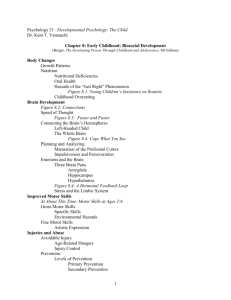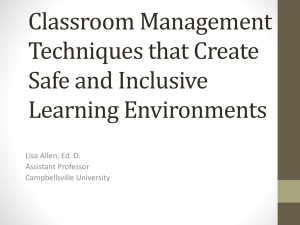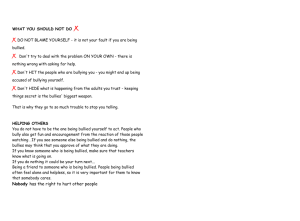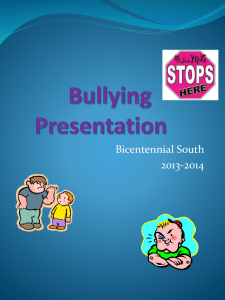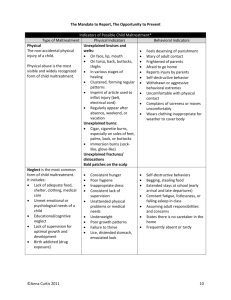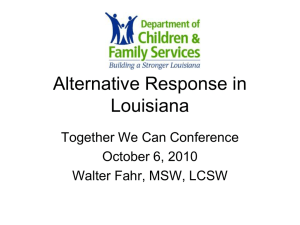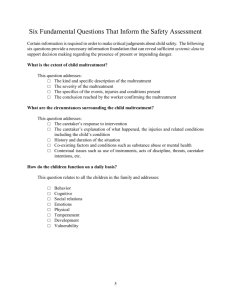E-RISK STUDY - Royal College of Psychiatrists
advertisement
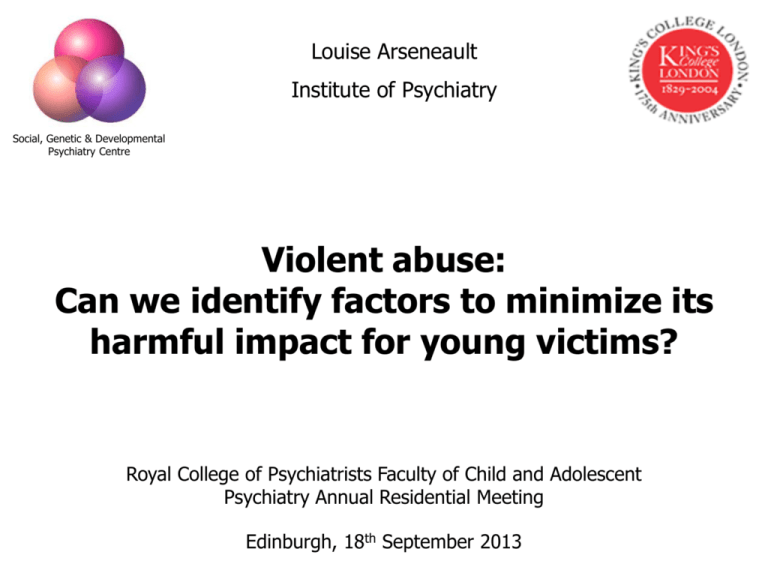
Louise Arseneault Institute of Psychiatry Social, Genetic & Developmental Psychiatry Centre Violent abuse: Can we identify factors to minimize its harmful impact for young victims? Royal College of Psychiatrists Faculty of Child and Adolescent Psychiatry Annual Residential Meeting Edinburgh, 18th September 2013 Parallels between bullying and maltreatment Bullying Maltreatment intent to harm intent to harm physical/verbal physical/verbal exclusion reject/neglect repeated long lasting prevalence = 13% prevalence = 15% imbalance of power imbalance of power Differences between bullying and maltreatment Bullying Maltreatment perpetrators – peers perpetrators – adults impact = emerging impact = well studied The E-Risk Longitudinal Twin Study Follow up Lifetime child maltreatment Child maltreatment • Interview from Child Development Study – Disciplined severely enough to have been hurt? – Worried that someone else may have harmed child? – Social service involvement • Research workers took detailed notes of the events reported by mothers • All cases reviewed by office team which rated likelihood that child had been harmed – not maltreated – possibly or definitely maltreated The E-Risk Longitudinal Twin Study Follow up Lifetime child maltreatment Mothers’ history of abuse Mothers’ history of abuse Childhood Trauma Questionnaire (CTQ) – Abuse (Emotional, Physical, and Sexual) – Neglect (Emotional and Physical) • • • • I felt loved ………………………………………………………… I thought my parents wished I had never been born ………… I felt that someone in my family hated me ……………………. People in my family hit me so hard that it left me with bruises or marks ………………………………………………………… • I believe I was sexually abused ………………………………... Mothers’ and children’s experiences of maltreatment Mothers’ maltreatment Children’s maltreatment Present 26% None 74% Jaffee et al., JAH, 2013 Mothers’ and children’s experiences of maltreatment Mothers’ maltreatment Children’s maltreatment 56% families with maltreatment Present 26% 81 mothers exposed to severe maltreatment None 74% Jaffee et al., JAH, 2013 Mothers’ and children’s experiences of maltreatment Mothers’ maltreatment 81 mothers exposed to severe maltreatment 44% families escaped maltreatment Jaffee et al., JAH, 2013 Promotive factors • Sibling warmth • Maternal warmth • Intimate relationship with partner • High SES • High social support % of children Prevalence of children’s maltreatment according to promotive factors Children with maltreatment Children without maltreatment Factors breaking the cycle of violence from one generation to the next 5 Odds Ratio 4 3 2 1 ns ns ns 0 Jaffee et al., JAH, 2013 Factors breaking the cycle of violence from one generation to the next 5 Odds Ratio 4 3 2 1 ns ns 0 Jaffee et al., JAH, 2013 The E-Risk Longitudinal Twin Study Follow up Childhood bullying Being frequently bullied is associated with experiencing psychotic symptoms 5 Controlling for Risk ratio 4 3 Individual and socioeconomic factors Genetic susceptibility Children’s psychopathology 2 1 Baseline risk Arseneault et al., Am J Psychiatry, 2011 Being bullied is associated with emotional and behavioural problems 0.6 Effect Size (d) 0.4 0.2 0 Primary Secondary School School Life Time Emotional Problems Primary Secondary School School Life Time Behavioural Problems Shakoor et al., JACP, 2011 Bullying as a risk factor for maladjustment Not all bullied children go on to experience difficulties What factors protect bullied children form developing emotional and behavioural difficulties? Text here? Family factors Measures Source Ages Maternal warmth 2 raters coding expressed emotion (EE) 5 minute speech sample 5, 10 Sibling warmth Mother 7, 10 Atmosphere at home Home visitors 7, 10 Behaviorual problems (z-scores) Emotional problems (z-scores) Maternal warmth protects children from the impact of being bullied 0.6 0.4 0.2 0 -0.2 -0.4 -0.6 Bullied Not bullied High maternal warmth 0.6 0.4 0.2 0 -0.2 -0.4 -0.6 Bullied Not bullied Low maternal warmth Bowes et al., JCPP, 2010 Behaviorual problems (z-scores) Emotional problems (z-scores) Sibling warmth protects children from the impact of being bullied 0.6 0.4 0.2 0 -0.2 -0.4 -0.6 Bullied Not bullied High sibling warmth 0.6 0.4 0.2 0 -0.2 -0.4 -0.6 Bullied Not bullied Low sibling warmthBowes et al., JCPP 2010 Bowes et al., JCPP, 2010 Behaviorual problems (z-scores) Emotional problems (z-scores) A positive atmosphere at home protects children from the impact of being bullied 0.8 0.6 0.4 0.2 0 -0.2 -0.4 -0.6 -0.8 Bullied Not bullied High positive atmosphere at home 0.8 0.6 0.4 0.2 0 -0.2 -0.4 -0.6 -0.8 Bullied Not bullied Low positive atmosphere at home Bowes et al., JCPP, 2010 Conclusions • Childhood maltreatment and bullying victimization contribute to the cycle of violence and to children’s mental health problems • Healthy relationships in the family can break the transmission of abuse from one generation to the next and can also protect children from developing emotional and behavioural difficulties after being bullied Thank you!

